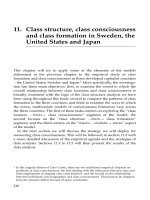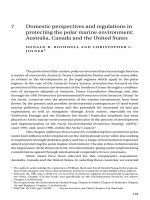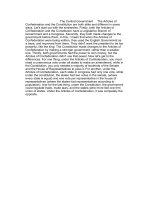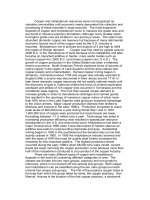4 2 5 meet the united states government
Bạn đang xem bản rút gọn của tài liệu. Xem và tải ngay bản đầy đủ của tài liệu tại đây (3.16 MB, 12 trang )
Suggested levels for Guided Reading, DRA,™
Lexile,® and Reading Recovery™ are provided
in the Pearson Scott Foresman Leveling Guide.
Meet the
United States
Government
by Joshua Nissenbaum
Genre
Expository
nonfiction
Comprehension
Skills and Strategy
• Main Idea and
Details
• Generalize
• Summarize
Text Features
• Captions
• Glossary
• Diagram
Scott Foresman Reading Street 4.2.5
ISBN 0-328-13440-6
ì<(sk$m)=bde ad< +^-Ä-U-Ä-U
Reader Response
Meet the
United States
Government
1. Why is the concept of three branches of
government a main idea of this book? Use a
graphic organizer like the one below to show
how the three branches function as supporting
details to the main idea.
Main Idea
Detail
Detail
Detail
2. Reread pages 10–13 and summarize what the
Cabinet does.
3. The Latin word constitution means “established.”
It comes from com and statuere, which mean “set
up.” Explain why Constitution is an appropriate
name for the document that outlines our
government.
4. Two requirements
for the
President and the
by Joshua
Nissenbaum
Vice-President are that they be at least thirtyfive years old and born in the United States. Tell
whether you think these are good requirements
and why you think as you do.
Editorial Offices: Glenview, Illinois • Parsippany, New Jersey • New York, New York
Sales Offices: Needham, Massachusetts • Duluth, Georgia • Glenview, Illinois
Coppell, Texas • Ontario, California • Mesa, Arizona
Did you ever think about how the United
States runs? You’ll learn that it’s all about
politics.
Let’s start with the President of the United
States. It is the President’s responsibility to make
sure that the country runs smoothly. But the
President doesn’t do it alone.
Our government is divided into three
branches. They are the executive, legislative,
and judicial branches. Each branch has its own
responsibilities and powers. The President is the
head of only one branch, the executive branch.
Every effort has been made to secure permission and provide appropriate credit for
photographic material. The publisher deeply regrets any omission and pledges to
correct errors called to its attention in subsequent editions.
Unless otherwise acknowledged, all photographs are the property of Scott Foresman,
a division of Pearson Education.
Photo locators denoted as follows: Top (T), Center (C), Bottom (B), Left (L), Right (R),
Background (Bkgd)
1 ©Bettmann/Corbis; 3 © Wally McNamee/Corbis; 4–5 © Bettmann/Corbis; 7 © Wally
McNamee/Corbis; 8 © Bettmann/Corbis; 9 © Jason Reed/Reuters/Corbis; 10–11 © Mannie
Garcia/Reuters/Corbis; 12 © Reuters/Corbis; 13 © Jason Reed/Reuters/Corbis; 14 © Eric
Draper/White House Photo/Corbis; 15 ©Brooks Kraft/Corbis; 16 © Bettmann/Corbis;
17 ©Brooks Kraft/Corbis; 18 © Bettmann/Corbis
ISBN: 0-328-13440-6
Copyright © Pearson Education, Inc.
All Rights Reserved. Printed in the United States of America. This publication is
protected by Copyright, and permission should be obtained from the publisher
prior to any prohibited reproduction, storage in a retrieval system, or transmission
in any form by any means, electronic, mechanical, photocopying, recording, or
likewise. For information regarding permission(s), write to: Permissions Department,
Scott Foresman, 1900 East Lake Avenue, Glenview, Illinois 60025.
2 3 4 5 6 7 8 9 10 V0G1 14 13 12 11 10 09 08 07 06 05
The Presidential Seal
3
How was this government created? Well,
the United States began as a group of thirteen
British colonies in the 1600s. Life in the colonies
was different from life back in Britain. There, the
King of England and the English government still
made all the laws. The colonists thought that
many of those laws were unfair.
On July 4, 1776, the colonies declared
independence from Britain and King George
III. They fought against the British in the
Revolutionary War. By 1783, the colonies had
won the right to create their own government.
4
It took the colonists about eight years to
decide on a form of government. They were
afraid of giving the government too much power.
The leaders of the colonies were known as the
“founding fathers” of the United States. They
created a new system of government, which
they outlined in the Constitution. By 1788 the
colonies accepted the Constitution, and George
Washington, a humble man, became the first
President in 1789.
5
A system of checks and balances on the three
branches of goverment make it hard for one
branch to get too powerful.
The legislative branch has to do with lawmaking.
This branch makes laws and collects taxes, and it can
declare war. It is known as Congress.
The Congress is split into two groups, or
houses. The first house is called the Senate. It
is made up of one hundred senators. They are
elected every six years.
The second house is the House of
Representatives. It is made up of 435
representatives. They are elected every two years.
Senators and representatives are elected
by the citizens of a state. They make sure that
the government takes care of the people
in their state.
Congress must work with the other two
branches of government to do its job. This is part
of the system of checks and balances. When the
President names people for certain important
jobs, the Senate approves or rejects those people.
The legislative branch has that power over the
executive branch.
Senators and representatives often have to attend hearings.
The Capitol
building, where the
Senate and House
of Representatives
go to work
6
7
Senators and representatives make new laws.
The President can sign these new laws into effect
or veto—reject—them.
The President isn’t the only one who makes
sure the legislative branch doesn’t gain too much
power. The judicial branch also helps preserve
the system of checks and balances.
Leading the judicial branch of the government
is the Supreme Court. It is the most powerful
court in the country. The Supreme Court has nine
judges known as justices. It is their job to make
sure that the laws of the United States agree
with the Constitution.
The Supreme Court justices hold their
positions for life. The President chooses the
justices, but the Senate decides whether to
accept or reject them. In this way, the executive
and legislative branches both keep check on the
power of the judicial branch.
The members of the Supreme Court in 2003
The opening of Congress
8
9
The executive branch of the government is
what most people think of when they say “the
government.” This branch enforces the laws
Congress makes and upholds the Constitution.
The executive branch is so large that it is divided
into departments. The President acts as the
head of all these departments. The directors, or
secretaries, of each department
form a group called
the Cabinet.
Maybe you have heard of some of these
departments. There is the Department of
State, the Department of the Treasury, and the
Department of Defense. Over the years these
departments have grown, and new departments
have been added. Now there are fifteen
executive departments.
Some of these departments are further
divided into agencies, which include the military
and the FBI.
The President is
in charge of many
departments and
agencies.
11
Executive departments are responsible for
everything from printing money to making sure
the food we buy at our supermarket is safe.
These departments employ millions of people.
The secretaries of each department are chosen
by the President and are very powerful. They
make important decisions. The secretaries help
the President understand what each department
is doing. The President relies on their advice to
make decisions and lead the country.
The Department of Homeland Security is the
newest executive department. It was created in
2002, following the attacks on the World Trade
Center, and the Pentagon on September 11,
2001. Its job is to protect the United States from
future terrorist attacks.
President Bush meets with his Cabinet in 2003.
12
President George W. Bush created the Department
of Homeland Security to protect the United States
from terrorism.
13
The President is elected by the citizens of
the United States. Once elected, the President
serves in office for a term of four years. The
Constitution does not allow a President to be
elected to more than two terms.
Any presidential candidate must be at least
thirty-five years old and have been born in the
United States. The same requirements apply to
the job of Vice-President.
The President has the power to lead the
country. The President also represents the United
States to the rest of the world.
The founding fathers were very careful to
limit the powers of the President. The legislative
and judicial branches have power to review
the actions of the President. For example, the
President is allowed to make agreements with
other countries, but the Senate must approve
those agreements.
President Bush speaks with dignitaries from other countries.
President
George W. Bush
14
15
Why limit the powers of the President? To
understand why, we have to go back to when the
colonies were ruled by King George III.
The king was a very vain man. He placed what
he wanted above the good of the colonists.
To pay for his war against the French, the king
expected the colonists to pay taxes. The colonists
were howling in protest at this. To make sure no
President could do the same, the Constitution
says that any of the President’s decisions must be
reviewed by the other branches of government.
The colonists wanted to make sure a powerhungry leader couldn’t gain control.
When a new President is elected, his first
action is to take the following oath:
“I do solemnly swear (or affirm) that I will
faithfully execute the office of President of the
United States and will to the best of my ability
preserve, protect, and defend the Constitution of
the United States.”
The Vice-President is also required to take
an oath. This oath begins, “I do solemnly swear
that I will defend the Constitution of the United
States against all enemies. . .”
President George W. Bush is sworn into office.
King George
III of England
ruled the
colonists
according
to his needs,
not theirs.
16
17
The Constitution gives the President enough
power to lead the country. The Constitution
also gives the country enough power to lead
the President! By splitting power among three
branches of government, the founding fathers
made sure that no one person could take control
of the country.
So far there have been forty-two different
Presidents. Each one of them has been guided by
the Constitution.
Our first President, George Washington
Our System of
Checks and Balances
Executive Branch
Can stop
President’s
veto
Led by the President
Can veto laws
Congress has
passed
Legislative Branch
Can keep
a law from
moving
forward
Decides who
becomes a
judge
Led by Congress
Makes and changes laws
Can keep a law
from moving
forward
One part of
branch chooses
judges
Judicial Branch
Led by Supreme Court
18
19
Glossary
Constitution n.
the written set of
fundamental principles
by which the United
States is governed.
howling v. making loud
noises of distress.
humble adj. modest, not
arrogant.
Reader Response
politics n. the work of
government; public
business.
responsibility n.
obligation.
1. Why is the concept of three branches of
government a main idea of this book? Use a
graphic organizer like the one below to show
how the three branches function as supporting
details to the main idea.
solemnly adv. seriously;
earnestly.
Main Idea
vain adj. proud;
inflated.
Detail
Detail
Detail
2. Reread pages 10–13 and summarize what the
Cabinet does.
3. The Latin word constitution means “established.”
It comes from com and statuere, which mean “set
up.” Explain why Constitution is an appropriate
name for the document that outlines our
government.
4. Two requirements for the President and the
Vice-President are that they be at least thirtyfive years old and born in the United States. Tell
whether you think these are good requirements
and why you think as you do.
20









